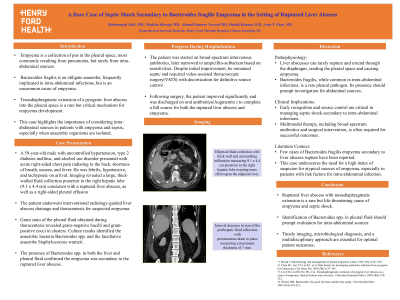Monday Poster Session
Category: Infections and Microbiome
P3461 - A Rare Case of Septic Shock Secondary to Bacteroides fragilis Empyema in the Setting of Ruptured Liver Abscess
Monday, October 27, 2025
10:30 AM - 4:00 PM PDT
Location: Exhibit Hall

Has Audio
.jpeg.jpg)
Mohammad Alali, MD
Henry ford macomb hospital
Clinton Township, MI
Presenting Author(s)
Mohammad Alali, MD, Madeha Khwaja, MD, Ahmed Kunwer Naveed, MD, Shefali Khanna, MD, Anne Chen, MD
Henry ford macomb hospital, Clinton Township, MI
Introduction: Empyema, a severe condition, can rarely arise from liver infections. Bacteria may translocate from the liver to the pleural space through various mechanisms. Bacteroides spp., a virulent anaerobe involved in polymicrobial intra-abdominal infections, can cause significant tissue destruction. This case of Bacteroides fragilis empyema, resulting from a ruptured liver abscess, highlights the uncommon pathophysiological processes by which liver infections can lead to empyema
Case Description/Methods: A 59-year-old male with uncontrolled hypertension, type 2 diabetes mellitus, and alcohol use disorder presented with acute right-sided chest pain radiating to the back, along with shortness of breath, nausea, and fever. He was febrile, hypotensive, and tachypneic. A CT scan was performed to rule out aortic dissection, revealing a mild ascending aortic aneurysm (4.1 cm) and a large elliptical fluid collection (9.1 x 4.4 cm) with thick walls and surrounding infiltration posterior to the right hepatic lobe, suggesting a ruptured liver abscess. A right-sided pleural effusion was also noted. Ultrasound confirmed a 9.6 cm fluid collection in the right hepatic lobe, consistent with a liver abscess. The patient underwent interventional radiology-guided liver abscess drainage and thoracentesis.
Gram stain of the pleural fluid revealed gram-negative bacilli and gram-positive cocci in clusters. Cultures identified Bacteroides spp. and Staphylococcus warneri, confirming empyema secondary to the ruptured liver abscess. Initially, the patient received broad-spectrum IV antibiotics, including piperacillin-tazobactam, which was later narrowed to ampicillin-sulbactam based on culture sensitivities. Despite initial improvement, the patient continued to show signs of sepsis, necessitating video-assisted thoracoscopic surgery (VATS) with decortication for definitive management. Post-VATS, the patient recovered significantly and was discharged on oral antibiotics to complete the treatment
Discussion: This case illustrates a rare complication of a ruptured liver abscess leading to empyema. While liver abscesses often result in sepsis or peritonitis, translocation of bacteria to the pleural space is uncommon but life-threatening. The virulence of Bacteroides spp. underscores the critical nature of this infection. Timely diagnosis through imaging and microbiological analysis, coupled with antibiotics and surgical drainage, is crucial for successful management
Disclosures:
Mohammad Alali, MD, Madeha Khwaja, MD, Ahmed Kunwer Naveed, MD, Shefali Khanna, MD, Anne Chen, MD. P3461 - A Rare Case of Septic Shock Secondary to <i>Bacteroides fragilis</i> Empyema in the Setting of Ruptured Liver Abscess, ACG 2025 Annual Scientific Meeting Abstracts. Phoenix, AZ: American College of Gastroenterology.
Henry ford macomb hospital, Clinton Township, MI
Introduction: Empyema, a severe condition, can rarely arise from liver infections. Bacteria may translocate from the liver to the pleural space through various mechanisms. Bacteroides spp., a virulent anaerobe involved in polymicrobial intra-abdominal infections, can cause significant tissue destruction. This case of Bacteroides fragilis empyema, resulting from a ruptured liver abscess, highlights the uncommon pathophysiological processes by which liver infections can lead to empyema
Case Description/Methods: A 59-year-old male with uncontrolled hypertension, type 2 diabetes mellitus, and alcohol use disorder presented with acute right-sided chest pain radiating to the back, along with shortness of breath, nausea, and fever. He was febrile, hypotensive, and tachypneic. A CT scan was performed to rule out aortic dissection, revealing a mild ascending aortic aneurysm (4.1 cm) and a large elliptical fluid collection (9.1 x 4.4 cm) with thick walls and surrounding infiltration posterior to the right hepatic lobe, suggesting a ruptured liver abscess. A right-sided pleural effusion was also noted. Ultrasound confirmed a 9.6 cm fluid collection in the right hepatic lobe, consistent with a liver abscess. The patient underwent interventional radiology-guided liver abscess drainage and thoracentesis.
Gram stain of the pleural fluid revealed gram-negative bacilli and gram-positive cocci in clusters. Cultures identified Bacteroides spp. and Staphylococcus warneri, confirming empyema secondary to the ruptured liver abscess. Initially, the patient received broad-spectrum IV antibiotics, including piperacillin-tazobactam, which was later narrowed to ampicillin-sulbactam based on culture sensitivities. Despite initial improvement, the patient continued to show signs of sepsis, necessitating video-assisted thoracoscopic surgery (VATS) with decortication for definitive management. Post-VATS, the patient recovered significantly and was discharged on oral antibiotics to complete the treatment
Discussion: This case illustrates a rare complication of a ruptured liver abscess leading to empyema. While liver abscesses often result in sepsis or peritonitis, translocation of bacteria to the pleural space is uncommon but life-threatening. The virulence of Bacteroides spp. underscores the critical nature of this infection. Timely diagnosis through imaging and microbiological analysis, coupled with antibiotics and surgical drainage, is crucial for successful management
Disclosures:
Mohammad Alali indicated no relevant financial relationships.
Madeha Khwaja indicated no relevant financial relationships.
Ahmed Kunwer Naveed indicated no relevant financial relationships.
Shefali Khanna indicated no relevant financial relationships.
Anne Chen indicated no relevant financial relationships.
Mohammad Alali, MD, Madeha Khwaja, MD, Ahmed Kunwer Naveed, MD, Shefali Khanna, MD, Anne Chen, MD. P3461 - A Rare Case of Septic Shock Secondary to <i>Bacteroides fragilis</i> Empyema in the Setting of Ruptured Liver Abscess, ACG 2025 Annual Scientific Meeting Abstracts. Phoenix, AZ: American College of Gastroenterology.
